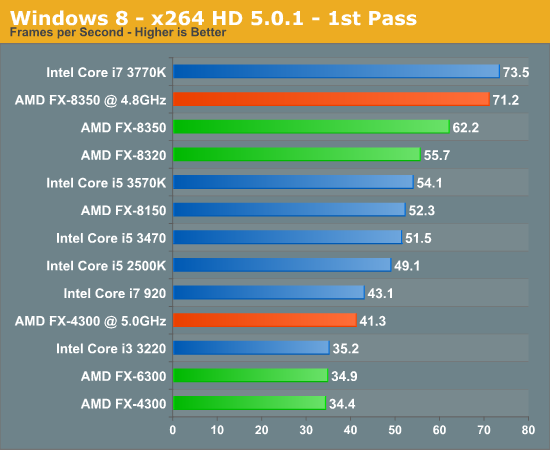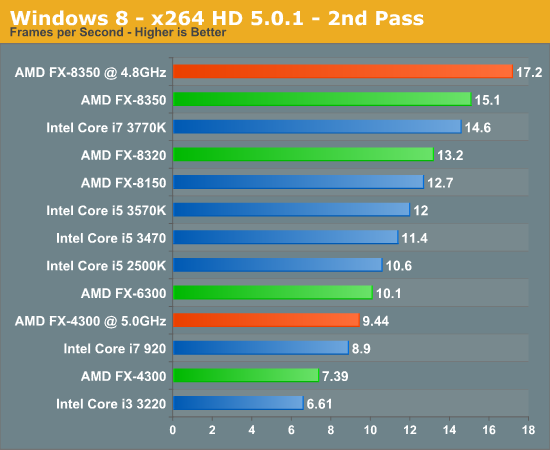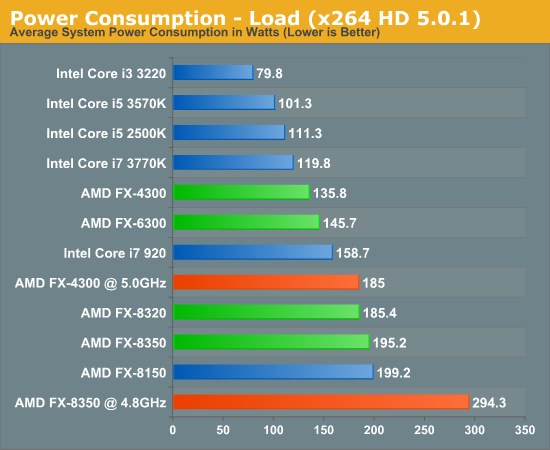The Vishera Review: AMD FX-8350, FX-8320, FX-6300 and FX-4300 Tested
by Anand Lal Shimpi on October 23, 2012 12:00 AM ESTOverclocking
AMD's FX architecture was designed for very high clock speeds. With Piledriver we're able to see some of that expressed in overclocking headroom. All of these chips should be good for close to 5GHz depending on your luck of the draw and cooling. For all of these overclocking tests I used AMD's branded closed loop liquid cooler which debuted back with the original FX launch. I didn't have enough time to go through every chip so I picked the FX-8350 and FX-4300 to show the range of overclocks that may be possible. In my case the FX-4300 hit 5GHz with minimal effort, while the FX-8350 topped out at 4.8GHz (I could hit 5GHz but it wasn't stable through all of our tests). Both of these overclocks were achieved with no more than 10% additional core voltage and by simple multiplier adjustments (hooray for unlocked everything). The increase in performance is substantial:


The increase in power consumption is pretty bad however, you do pay for these types of voltage driven overclocks:

The 5GHz FX-4300 is pushed into FX-8300 territory, while the 4.8GHz 8350 is in a league of its own at just under 300W of total system power consumption.










250 Comments
View All Comments
c0d1f1ed - Tuesday, October 23, 2012 - link
The Projected Performance page doesn't appear to take AVX2 and TSX into account, not to mention improved Hyper-Threading performance by having an extra execution port. The 10-15% number is for single-threaded workloads only. Everything else will see a much bigger leap.AMD is screwed unless it adds AVX2 and TSX support sooner rather than later. They haven't made a single mention of it yet...
tekphnx - Tuesday, October 23, 2012 - link
From a price-performance perspective, I think that FX-6300 is the most interesting part here. For barely more than the i3-3220, you get essentially the same performance in games and 20-30% better performance in multithreaded applications. And, as time goes on and games become more multithreaded, the FX-6300 will pull ahead in games, too. At 95w, the power consumption is much higher than Intel, but it's manageable. Plus, it's overclockable, unlike the i3.Spunjji - Tuesday, October 23, 2012 - link
Add in the potential for ~10% savings under load with a bit of undervolting and it looks even better. One to watch for those who, like me, would rather buy AMD if it doesn't smell like shooting yourself in the foot.CeriseCogburn - Tuesday, October 30, 2012 - link
Got any toes left ?lol
Didn't think so.
rocky12345 - Tuesday, October 23, 2012 - link
HelloI am a long time reader of this site pretty much since it first started. Heck in the time this site has been running I have gone through probably 35 or more computers & currently have 11 in my home that are used for different tasks. I also went through a wife but thats another story to tell lol.
Anyways what I was wondering is this. In the past with AMD I noticed a huge gain in CPU out put when raising the bus speed up to as far as the hardware would go. What I am wondering is what if you took a 8350 raised the bus up as high as it would go but keep the multi set that the CPU would run at default speed & do some test in both single threaded & multi threaded programs as well as a few games where this CPU is a bit lacking to see if the CPU itself is being held back by the bus. Then try to do both the bus at high & raise the Multi to the max CPU speed of 4.8Ghz & see what raising both the bus & CPU speed do.
I am hoping it has the same effect as it did in the older AMD CPU's & gives a nice boost. I think maybe the bulldozer & piledriver core might be held back by a lack of bandwidth to the rest of the system resources. If not then at least it was a fun little side project for you guys. maybe raise the memory speed as well to make sure that is not the issue too. Just an idea that may open up some hidden performance in the CPU hopefully. I would do it myself but at the moment the only AMD system I have left if a older Athlon 64 x2 6400+ that the step son uses to surf the web & play a few games on.
thanks
lmcd - Tuesday, October 23, 2012 - link
If I remember right with AM3+ there isn't really a bus to raise.CeriseCogburn - Tuesday, October 30, 2012 - link
Oh yeah, how come we don't have the big speculation all the time solidified into the standard commentary and "looking for the validation on the tests" concerning what's wrong with the amd cpu's ?I mean we get that argument when it's time to attack their competitors in the articles here, the "well established theory" that "turns out to be wrong" "years later" is used as the "standing thesis" as to why " xXxxxx" did so poorly in this test against AMD, "as we expected" says the reviewer, making sure to note the "weakness suspected" has reared it's ugly head...
Yeah, another thing that is so bothersome.
I guess amd's architecture sucks so badly, nothing can explain it's constant failures.
boeush - Tuesday, October 23, 2012 - link
Firstly, by 2014 Intel will be already on a 14 nm process. Add Intel's already superior (3D fin) transistor technology, coupled with massive R&D budgets on a slew of parallel projects to further refine the basic process tech, and the situation is not going to get any prettier for AMD any time soon.Second, computing is increasingly going mobile (laptops, tablets, phones, phablets, etc.) The number one thing for mobile is power efficiency. AMD's CPUs absolutely suck at that; they are multiple generations behind Intel (and not all of that can be blamed on process lag.)
Third, AMD's trump card in the consumer space so far has been integrated graphics, but with Haswell and then Broadwell Intel's going to take that advantage away. So, by 2014 AMD won't have any feature set advantages left.
Fourth, AMD's other hopes have been in the HPC/server domain, but there again power efficiency is getting increasingly more important, and AMD is losing the war. Moreover, with its new MIC architecture ("Xeon Phi") now debuted (and it will be continually refined going forward) Intel's poised to capture even more of the HPC market, and AMD currently has no answer to that product line.
Seems to me that AMD is hosed on all fronts, unless they can pull not just one but a flock of fire-breathing dragons out of a hat, soon if not today.
lmcd - Tuesday, October 23, 2012 - link
The "process advantage" didn't do shit for Intel. Note how Ivy Bridge had horrible overclocking compared to anticipated, Intel's shift to mobile architecture benefits in new architectures, and that Microsoft is finally looking at helping AMD out with things like the scheduler in Win8, etc.AMD is succeeding at power efficiency in mobile: the Trinity review correctly indicated AMD's success there in nearly closing the gap to Sandy Bridge (and Ivy? I forget now. It was close though).
Finally, IT IS A PROCESS NODE CHANGE. It's 28nm. BD/PD are 32nm. Besides, a GCN IGP is really attractive, and will still dominate versus Broadwell. VLIW5->4 was a tiny change and yet AMD managed to pull a pretty nice performance jump out of it; GCN was comparatively huge, designed for 28nm, and set to scale better as evidenced by the already low-power 7750 desktop.
The only worrying thing about Steamroller is whether the caches and memory controller speed up. If those don't, the platform is likely to be bottlenecked horribly.
c0d1f1ed - Tuesday, October 23, 2012 - link
That's partially due to the lower quality TIM they used on Ivy Bridge, and mostly due to bringing the Sandy Bridge design to the 22 nm TriGate process in a verbatin manner. Despite being a radically new process, they didn't change anything in the design to optimize for it. Haswell on the other hand is designed from the ground up to use the TriGate process. So it will show the process advantage much more clearly.